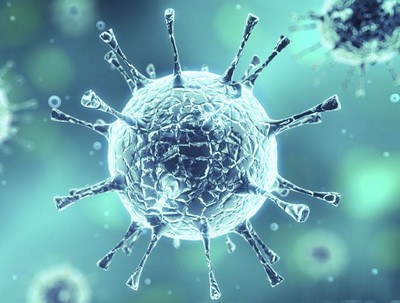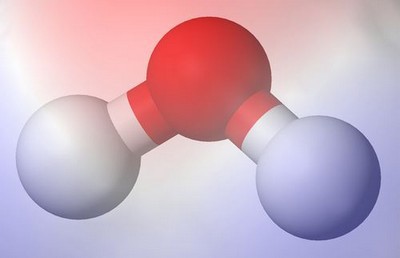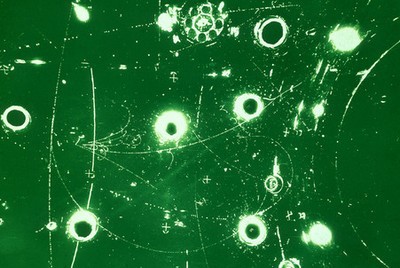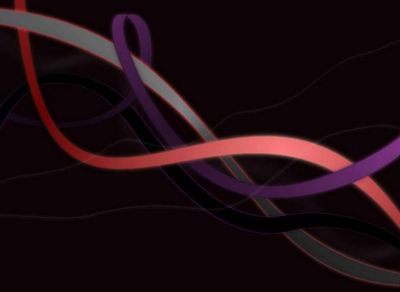Travel to the microworld
In a previous article, we talked about giant numbers . We can say that we made a journey to infinity, and when we approached the Graham Number, I personally had the feeling that just a little more - and we would touch it with our hand. Today I offer you another journey. This time in the microworld - the world of small objects. So small that among all those we consider, the grain of sand will be the largest. I must say right away that this article is not about physics. We will not talk about quantum effects, the uncertainty principle, and string theory. I am not a physicist (however, I think that you understood this on the basis of my previous text). This article is about numbers, scale and beauty. Welcome.
But we will start from a completely different perspective. Before embarking on a journey to the depths of matter, let us turn our gaze up. It seems to me that the macroscale is still familiar to us a little better than the micro. An educated reader more or less imagines how great the distances are in the universe. For example, it is known that to the Moon, on average, almost 400 thousand kilometers, to the Sun - 150 million, to the now fashionable Pluto (which is no longer visible without a telescope) - 6 billion, to the nearest star Proxima Centauri (not visible too) - 40 trillion, 25 quintillion to the nearest large galaxy of the Andromeda nebula (but it is just remarkably visible without any instruments) and finally to the outskirts of the observable Universe (whether they are visible or not - a moot point) - 130 sextillion. Impressive of course, but we all love space news and, frankly, somewhere deep down already resigned to the fact that the cosmos is very, very, very large. And the difference between all these "quadri-", "quinti-" and "sexty-" does not seem so huge, although they differ by a thousand times. The microworld is quite another matter. Is it possible that so many interesting things can be hidden in him, because he simply has nowhere to fit in there. So common sense tells us and is mistaken.
Try to answer such a question. If we put aside the smallest known distance in the universe at one end of the logarithmic scale, and the largest at the other, then what will be in the middle? What is this “average” distance? If you just thought about galaxies and stars, then probably assume that it should be large enough, because the Universe is so huge. But in fact, this distance will be approximately 0.1 millimeters. Amazing right? Something very inexplicable is happening in this very microcosm, since it outweighs the bulk of the whole cosmos. So, 0.1 mm is the size of a grain of sand, let's start with it.

A grain of sand is one of the smallest objects that we still see with the naked eye. 100 grains of sand, placed in a row, will fit on the nail of a human finger. 10 thousand grains of sand - and now in front of us is a meter. And if you place them “side by side” along the earth's equator, then we need 400 billion pieces. Just. Do you realize that all these grains of sand can be collected in one big, but not at all huge, bag, and it will weigh only about a ton?
What else do we have that can hardly be considered? Human hair. People’s hair is different, but on average their thickness is 50-70 microns, that is, 15-20 of them per millimeter. In order to lay out the distance to the moon, they will need 8 trillion hair (if you fold them not in length but in width, of course). Since there are about 100 thousand of them on the head of one person, then if you collect the hair from the entire population of Russia, it’s more than enough for the moon and even remains.

We move further - into the world of objects already invisible to the naked eye. Bacteria. Their size can vary 10 times - from 0.5 to 5 microns (although there are unique specimens up to 1 millimeter in size). Thus, in the thickness of a human hair, they will fit up to 100, and in a centimeter - up to 20 thousand pieces. If you increase the average bacterium to such a size that it fits comfortably in our palm (100 thousand times), the hair will become 5 meters thick. By the way, a whole quadrillion bacteria live inside the human body, and their total weight is 2 kilograms. Stop for a second and think about how much of you are bacteria. There are actually more of them than the cells of the body itself. So it is quite possible to say that a person is just such an organism, consisting of bacteria and viruses with small intersperses of something else.

Viruses. I can easily admit that to someone they seem approximately the same as bacteria - I myself sometimes use these words as synonyms. The sizes of viruses differ even more than bacteria - almost 100 thousand times. If this were the case with people, then they would be growth from 1 centimeter to 1 kilometer, and their social interaction would become a curious sight. But overall, viruses are smaller than bacteria. The average length of the most common varieties is 100 nanometers or 10 -7 degrees of a meter. If we again perform the approximation operation so that the virus becomes the size of a palm, then the length of the bacterium will be 1 meter and the hair thickness 50 meters.
And, by the way, it is on this scale that we are approaching sizes that we can no longer see through an optical microscope. And that's why. The wavelength of visible light is 400-750 nanometers, and to see objects smaller than this value is simply impossible (unless you apply some trick, for example, by making them emit). Trying to illuminate the object, the wave will simply go around it and will not be reflected. Sometimes they ask how the atom looks or what color it is.. Once upon a time, it seemed to me that to answer it you just need to look through a microscope, and if there is not enough magnification, then take another one and attach to the first, and then again and again, until you get a bright and clear image, which really obviously there will be some form and some color (yes, I was smart small and it seemed like a great idea to me). In fact, the atom does not look in any way. Just nothing at all. And not because our microscopes are not good enough, but because the size of the atom is less than the distance for which the very notion of “visibility” exists ... It just seemed important to me to note this because all further illustrations will be more likely just pictures, but not something really reflecting the shapes of the objects in question.
Back to the viruses. If we again take the thickness of a human hair for comparison, then about 500 pieces of medium size will fit them there. The next time you look at the hair found in the soup, imagine how a round dance of 1.5 thousand viruses goes around it. And along the circumference of the globe, 400 trillion viruses can be densely placed. Many. Such a distance in kilometers of light passes in 40 years. But if you put them all together, they easily fit on your fingertip. Just.

In general, on the nanometer scale, there are many different interesting objects, but we will dwell only on those whose names are widely known. Therefore, our next stop is molecules. For example, a DNA molecule with a width of 3 by 10 -9meter. That is, with an increase of a million times its width will be equal to 3 millimeters, and if in a billion - 3 meters (on the other hand, if you just take a billion molecules, they will not even be visible without glasses). Thus, the DNA molecule is several tens of times smaller than the average virus. Although this is not entirely honest, we are comparing width (DNA) with length (of virus). But all the same, the ratios here are roughly the same. Let's take a water molecule for comparison. Its approximate size is 3 by 10 -10 meters. There are 10 septillion in a glass of water of such molecules - about as many millimeters from us to the Andromeda Galaxy. And in a cubic centimeter of air, molecules are 30 quintillion (mainly nitrogen and oxygen).

Molecules are known to be composed of atoms, and their sizes are quite comparable. For example, the diameter of the carbon atom (the foundation of all life on Earth) is 3.5 by 10 -10 meters, that is, even slightly larger than water molecules. The hydrogen atom is 10 times smaller - 3 by 10 -11 meters. This, of course, is not enough. But how little? Striking any (healthy) imagination, the fact is that the smallest, barely distinguishable grain of salt consists of 1 quintillion atoms. And I do not mean coarse salt with large, clearly distinguishable granules, but fine salt - the one in salt shakers. On occasion, try to single out one of them, look at the light and say to yourself: “qui nti-lli-on” (by the way, this is 10 18) Let's go back to our standard scale and zoom in on the hydrogen atom so that it fits comfortably in the hand. The viruses will then be 300-meter in size, bacteria 3-kilometer, and the hair will become 150 kilometers thick, and even when it is lying, it will go beyond the atmosphere (and it can reach the moon in length).

We dive one step deeper. Such a small “step” is immediately by 4 orders of magnitude, as from the size of a football stadium to the size of a bee sitting in the center of its field. Particles. It should immediately be said that on such scales the very concept of size is rather arbitrary. And if we are talking about elementary particles, then we already have to consider which model we use, quantum or classical. The so-called “classic” electron diameter is 5.5 femtometers or 5.5 per 10 -15meter. The dimensions of the proton and neutron are even smaller and amount to about 1.5 femtometers. The irony is that protons are 1,836 times heavier than electrons - this alone has something to say about the conventions of the above dimensions. There are about the same number of protons in a meter as there are ants on planet Earth, although I’m not sure that these two values are somehow related to each other (personally, it’s shocking me not only that the proton is so small, but that the ants have there are too many of us somehow). We use the already familiar increase. The proton is conveniently in our palm, and then the size of the average virus will be equal to 7,000 kilometers (almost like the whole of Russia from west to east, by the way), and the hair thickness will be 2 times the size of the sun.

Do not you think that there’s simply nothing more to be? Yes, we heard something about quarks, but it’s hard to say anything definite about their size. It is assumed that they are somewhere in the range of 10 -19 - 10 -18 meters. The smallest - a true quark - with a diameter (let's write this word in quotation marks to remind you of the above) is 10 -22 meters. There is such a thing as neutrinos. Look at your palm. A trillion neutrinos emitted by the Sun flies through it every second. And you can not hide your hand behind your back. Neutrinos will easily pass through your body, and through the wall, and through our entire planet, and even through a layer of lead 1 light-year thick. The "diameter" of the neutrino is 10 -24meter - this particle is 100 times smaller than the true quark, or one billion times smaller than the proton, or 10 septillion times smaller than the tyrannosaurus. Almost as many times the tyrannosaurus itself is smaller than the entire observable Universe (more precisely, it was smaller until it died out). If you increase the neutrino so that it is the size of an orange, then even the proton will be 10 times larger than the Earth. Like this.

And now I sincerely hope that one of the following two things should strike you. Choose any of them and enjoy. First, we can go even further (and even make some meaningful assumptions about what will happen there). The second one - but at the same time, it is impossible to infinitely go deeper into matter, and soon we will come to a standstill. Which of these statements seems more surprising to you? Personally, I probably still have the second. That's just to achieve these same "dead end" sizes we have to go down another 11 orders of magnitude, if we count from the neutrino. That is, these sizes are 100 billion times smaller than neutrinos. By the same amount, a grain of sand is smaller than our entire planet, by the way. If this does not strike you, then I just don’t know what you can talk about ...
So, at sizes 10 -35meters, we are waiting for such a wonderful concept as the Planck length - the minimum distance possible in the real world (as far as it is commonly believed in modern science). Quantum strings still live here - objects quite remarkable from any point of view (for example, they are one-dimensional, they have no thickness), but for our theme it is important that their length is also within 10 -35 meters. Let's do our standard “magnifying” experiment for the last time. A quantum string becomes a convenient size, and we hold it in our hands like a pencil. In this case, the neutrino will be 7 times larger than the Sun, and the hydrogen atom will be 300 times the size of the Milky Way.

Finally, we came to the very structure of the universe - the scale at which space becomes like time, time into space, and various other bizarre things happen. There is nothing further (probably) ...
Well, I hope that you were interested, and that if you read to this place, you did not regret the time spent. If so, then do not be too lazy to go to the following link , and you can see all the same and much more, but only in pictures and with a scale of the real scale of micro- and macrocosm objects.
And if you notice any mistake in my text, please write about this in the comments. I will be happy to correct this text so that it more accurately reflects the reality surrounding us, so amazing and diverse.
But we will start from a completely different perspective. Before embarking on a journey to the depths of matter, let us turn our gaze up. It seems to me that the macroscale is still familiar to us a little better than the micro. An educated reader more or less imagines how great the distances are in the universe. For example, it is known that to the Moon, on average, almost 400 thousand kilometers, to the Sun - 150 million, to the now fashionable Pluto (which is no longer visible without a telescope) - 6 billion, to the nearest star Proxima Centauri (not visible too) - 40 trillion, 25 quintillion to the nearest large galaxy of the Andromeda nebula (but it is just remarkably visible without any instruments) and finally to the outskirts of the observable Universe (whether they are visible or not - a moot point) - 130 sextillion. Impressive of course, but we all love space news and, frankly, somewhere deep down already resigned to the fact that the cosmos is very, very, very large. And the difference between all these "quadri-", "quinti-" and "sexty-" does not seem so huge, although they differ by a thousand times. The microworld is quite another matter. Is it possible that so many interesting things can be hidden in him, because he simply has nowhere to fit in there. So common sense tells us and is mistaken.
Try to answer such a question. If we put aside the smallest known distance in the universe at one end of the logarithmic scale, and the largest at the other, then what will be in the middle? What is this “average” distance? If you just thought about galaxies and stars, then probably assume that it should be large enough, because the Universe is so huge. But in fact, this distance will be approximately 0.1 millimeters. Amazing right? Something very inexplicable is happening in this very microcosm, since it outweighs the bulk of the whole cosmos. So, 0.1 mm is the size of a grain of sand, let's start with it.

A grain of sand is one of the smallest objects that we still see with the naked eye. 100 grains of sand, placed in a row, will fit on the nail of a human finger. 10 thousand grains of sand - and now in front of us is a meter. And if you place them “side by side” along the earth's equator, then we need 400 billion pieces. Just. Do you realize that all these grains of sand can be collected in one big, but not at all huge, bag, and it will weigh only about a ton?
What else do we have that can hardly be considered? Human hair. People’s hair is different, but on average their thickness is 50-70 microns, that is, 15-20 of them per millimeter. In order to lay out the distance to the moon, they will need 8 trillion hair (if you fold them not in length but in width, of course). Since there are about 100 thousand of them on the head of one person, then if you collect the hair from the entire population of Russia, it’s more than enough for the moon and even remains.

We move further - into the world of objects already invisible to the naked eye. Bacteria. Their size can vary 10 times - from 0.5 to 5 microns (although there are unique specimens up to 1 millimeter in size). Thus, in the thickness of a human hair, they will fit up to 100, and in a centimeter - up to 20 thousand pieces. If you increase the average bacterium to such a size that it fits comfortably in our palm (100 thousand times), the hair will become 5 meters thick. By the way, a whole quadrillion bacteria live inside the human body, and their total weight is 2 kilograms. Stop for a second and think about how much of you are bacteria. There are actually more of them than the cells of the body itself. So it is quite possible to say that a person is just such an organism, consisting of bacteria and viruses with small intersperses of something else.

Viruses. I can easily admit that to someone they seem approximately the same as bacteria - I myself sometimes use these words as synonyms. The sizes of viruses differ even more than bacteria - almost 100 thousand times. If this were the case with people, then they would be growth from 1 centimeter to 1 kilometer, and their social interaction would become a curious sight. But overall, viruses are smaller than bacteria. The average length of the most common varieties is 100 nanometers or 10 -7 degrees of a meter. If we again perform the approximation operation so that the virus becomes the size of a palm, then the length of the bacterium will be 1 meter and the hair thickness 50 meters.
And, by the way, it is on this scale that we are approaching sizes that we can no longer see through an optical microscope. And that's why. The wavelength of visible light is 400-750 nanometers, and to see objects smaller than this value is simply impossible (unless you apply some trick, for example, by making them emit). Trying to illuminate the object, the wave will simply go around it and will not be reflected. Sometimes they ask how the atom looks or what color it is.. Once upon a time, it seemed to me that to answer it you just need to look through a microscope, and if there is not enough magnification, then take another one and attach to the first, and then again and again, until you get a bright and clear image, which really obviously there will be some form and some color (yes, I was smart small and it seemed like a great idea to me). In fact, the atom does not look in any way. Just nothing at all. And not because our microscopes are not good enough, but because the size of the atom is less than the distance for which the very notion of “visibility” exists ... It just seemed important to me to note this because all further illustrations will be more likely just pictures, but not something really reflecting the shapes of the objects in question.
Back to the viruses. If we again take the thickness of a human hair for comparison, then about 500 pieces of medium size will fit them there. The next time you look at the hair found in the soup, imagine how a round dance of 1.5 thousand viruses goes around it. And along the circumference of the globe, 400 trillion viruses can be densely placed. Many. Such a distance in kilometers of light passes in 40 years. But if you put them all together, they easily fit on your fingertip. Just.

In general, on the nanometer scale, there are many different interesting objects, but we will dwell only on those whose names are widely known. Therefore, our next stop is molecules. For example, a DNA molecule with a width of 3 by 10 -9meter. That is, with an increase of a million times its width will be equal to 3 millimeters, and if in a billion - 3 meters (on the other hand, if you just take a billion molecules, they will not even be visible without glasses). Thus, the DNA molecule is several tens of times smaller than the average virus. Although this is not entirely honest, we are comparing width (DNA) with length (of virus). But all the same, the ratios here are roughly the same. Let's take a water molecule for comparison. Its approximate size is 3 by 10 -10 meters. There are 10 septillion in a glass of water of such molecules - about as many millimeters from us to the Andromeda Galaxy. And in a cubic centimeter of air, molecules are 30 quintillion (mainly nitrogen and oxygen).

Molecules are known to be composed of atoms, and their sizes are quite comparable. For example, the diameter of the carbon atom (the foundation of all life on Earth) is 3.5 by 10 -10 meters, that is, even slightly larger than water molecules. The hydrogen atom is 10 times smaller - 3 by 10 -11 meters. This, of course, is not enough. But how little? Striking any (healthy) imagination, the fact is that the smallest, barely distinguishable grain of salt consists of 1 quintillion atoms. And I do not mean coarse salt with large, clearly distinguishable granules, but fine salt - the one in salt shakers. On occasion, try to single out one of them, look at the light and say to yourself: “qui nti-lli-on” (by the way, this is 10 18) Let's go back to our standard scale and zoom in on the hydrogen atom so that it fits comfortably in the hand. The viruses will then be 300-meter in size, bacteria 3-kilometer, and the hair will become 150 kilometers thick, and even when it is lying, it will go beyond the atmosphere (and it can reach the moon in length).

We dive one step deeper. Such a small “step” is immediately by 4 orders of magnitude, as from the size of a football stadium to the size of a bee sitting in the center of its field. Particles. It should immediately be said that on such scales the very concept of size is rather arbitrary. And if we are talking about elementary particles, then we already have to consider which model we use, quantum or classical. The so-called “classic” electron diameter is 5.5 femtometers or 5.5 per 10 -15meter. The dimensions of the proton and neutron are even smaller and amount to about 1.5 femtometers. The irony is that protons are 1,836 times heavier than electrons - this alone has something to say about the conventions of the above dimensions. There are about the same number of protons in a meter as there are ants on planet Earth, although I’m not sure that these two values are somehow related to each other (personally, it’s shocking me not only that the proton is so small, but that the ants have there are too many of us somehow). We use the already familiar increase. The proton is conveniently in our palm, and then the size of the average virus will be equal to 7,000 kilometers (almost like the whole of Russia from west to east, by the way), and the hair thickness will be 2 times the size of the sun.

Do not you think that there’s simply nothing more to be? Yes, we heard something about quarks, but it’s hard to say anything definite about their size. It is assumed that they are somewhere in the range of 10 -19 - 10 -18 meters. The smallest - a true quark - with a diameter (let's write this word in quotation marks to remind you of the above) is 10 -22 meters. There is such a thing as neutrinos. Look at your palm. A trillion neutrinos emitted by the Sun flies through it every second. And you can not hide your hand behind your back. Neutrinos will easily pass through your body, and through the wall, and through our entire planet, and even through a layer of lead 1 light-year thick. The "diameter" of the neutrino is 10 -24meter - this particle is 100 times smaller than the true quark, or one billion times smaller than the proton, or 10 septillion times smaller than the tyrannosaurus. Almost as many times the tyrannosaurus itself is smaller than the entire observable Universe (more precisely, it was smaller until it died out). If you increase the neutrino so that it is the size of an orange, then even the proton will be 10 times larger than the Earth. Like this.

And now I sincerely hope that one of the following two things should strike you. Choose any of them and enjoy. First, we can go even further (and even make some meaningful assumptions about what will happen there). The second one - but at the same time, it is impossible to infinitely go deeper into matter, and soon we will come to a standstill. Which of these statements seems more surprising to you? Personally, I probably still have the second. That's just to achieve these same "dead end" sizes we have to go down another 11 orders of magnitude, if we count from the neutrino. That is, these sizes are 100 billion times smaller than neutrinos. By the same amount, a grain of sand is smaller than our entire planet, by the way. If this does not strike you, then I just don’t know what you can talk about ...
So, at sizes 10 -35meters, we are waiting for such a wonderful concept as the Planck length - the minimum distance possible in the real world (as far as it is commonly believed in modern science). Quantum strings still live here - objects quite remarkable from any point of view (for example, they are one-dimensional, they have no thickness), but for our theme it is important that their length is also within 10 -35 meters. Let's do our standard “magnifying” experiment for the last time. A quantum string becomes a convenient size, and we hold it in our hands like a pencil. In this case, the neutrino will be 7 times larger than the Sun, and the hydrogen atom will be 300 times the size of the Milky Way.

Finally, we came to the very structure of the universe - the scale at which space becomes like time, time into space, and various other bizarre things happen. There is nothing further (probably) ...
Well, I hope that you were interested, and that if you read to this place, you did not regret the time spent. If so, then do not be too lazy to go to the following link , and you can see all the same and much more, but only in pictures and with a scale of the real scale of micro- and macrocosm objects.
And if you notice any mistake in my text, please write about this in the comments. I will be happy to correct this text so that it more accurately reflects the reality surrounding us, so amazing and diverse.
